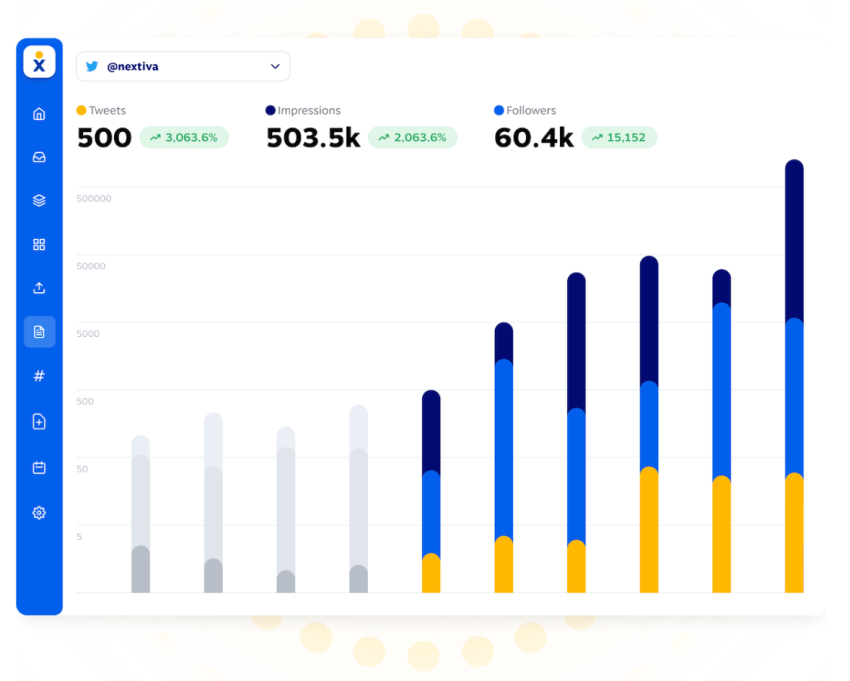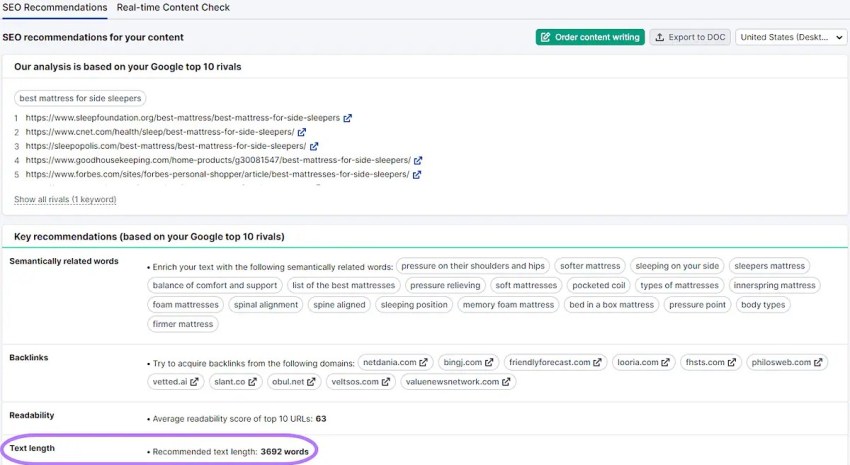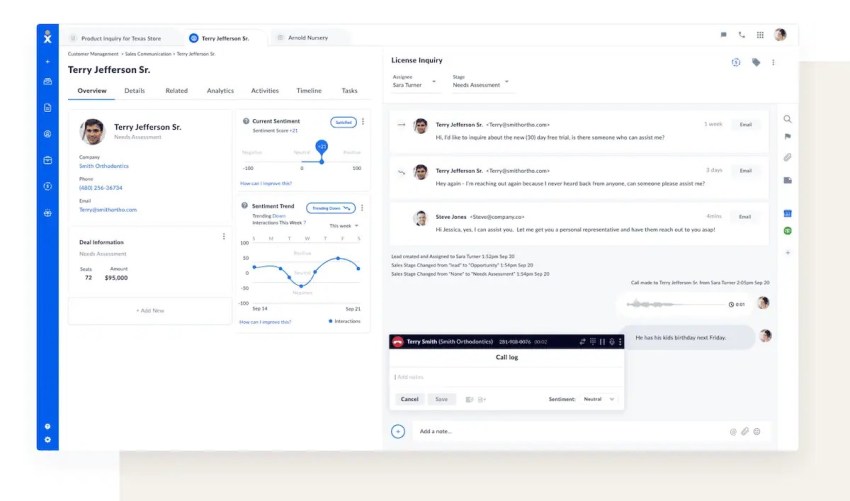Your online reputation is how people perceive your company, products, service, and brand online.
It’s like your brand’s digital business card, but not one you can polish to perfection once and distribute forever. Instead, your customers put it to the test daily — and potential customers rely on it to make their purchase decisions.
Research shows consumers are increasingly picky about trusting brands: 89% check online reviews before buying, and 64% prefer a responsive company over one that appears perfect.
In other words, building and maintaining your online reputation can’t just be an afterthought — it needs to be front and center of your big-picture business strategy. Here’s exactly how to do it, plus the tools to help you make it happen.

Is your CX falling short?
Assess and elevate your strategy with the Gartner® CX Maturity Model report.
Proactive Approaches for Building and Managing Your Online Reputation
The best part about nailing your online reputation? You don’t have to hold your breath and wait for a review or a social media mention to build brand reputation.
You can take matters into your own hands. How? By creating content, launching marketing campaigns, prioritizing search engine optimization (SEO), and leveraging partnerships to showcase your expertise, customer results, and credibility in the industry.
When you intentionally build your online presence, you show your target audience you have the knowledge to understand them and the experience to serve them.
And as your brand awareness jumps, so does your digital reputation.
1. Content marketing
With content marketing, the goal is to publish content your ideal customers find valuable and relevant. This way, you can educate, entertain, and empower them — and become their go-to resource when they have problems they are trying to solve.
Need some content marketing ideas? Try these:
- High-value written content: Focus on informative guides like blog posts and pair them with e-books or whitepapers for more in-depth topics. If you can invest more time and budget into your content, publishing industry reports is worth it.
- Customer success stories: “We help you grow your business” is an okay statement. “We helped [a specific company] 5x their revenue” is an extraordinary one. For example, Nextiva’s potential customers can read over 50 case studies that prove our expertise.
- Social media presence: Figure out the social media platforms where your ideal customers hang out and spend time publishing engaging content and joining conversations to build your name in the industry. Depending on your audience, Facebook, LinkedIn, X (formerly Twitter), and Instagram are great options.
- Partnerships with journalists and writers: Want positive press coverage? Check out platforms like Help a B2B Writer, Featured, Connectively (formerly HARO), and Qwoted to contribute to articles as an expert. It’s where writers search for contributions from pros like you.
- In-depth webinars: Live-teaching your audience is a great tactic on all fronts because it creates deeper engagement with viewers, you end up with a piece of video content you can repurpose in many ways, and you can connect with the industry leaders you bring on board (and tap into their audience). Get inspired by Clearscope’s webinar series.
2. Website optimization
Nearly 90% of consumers use search engines to research products and companies before making a purchase. In fact, according to the 2023 Edelman Trust Barometer study, people trust search engines significantly more than they do social media or traditional media.
An optimized website is a must — if potential customers can’t find you, they’ll likely go to your competitor.
Content marketing will give you a strong foundation to take the top spot on search engine results pages, but your work doesn’t end there. Once visitors land on your website, make sure they can:
- Instantly understand what you do and how you can help them.
- Navigate your website smoothly on any device.
- Easily find your products, services, prices, and steps to buy and get started.
- Get to know your backstory, values, and team.
Your website needs to build confidence. If a visitor keeps running into errors or outdated pages, the effect will be the opposite, so give your website the love it deserves.
3. Transparency and authenticity
A huge part of your brand image is how you present your values and goals and how you use them in practice.
Of course, you could let your audience figure out what you stand for and how you can serve them. The better way is to actively discuss your company’s mission and practices.
This means showing what you stand for as a brand and how your company’s people make it happen. Throughout your website, social media, emails, and even product packaging, you can emphasize and reiterate your priorities and your purpose as a business.
Here are some examples to inspire you:
- A health and wellness business can showcase its holistic approach to each customer it treats and its emphasis on a balanced workload for every employee.
- A sportswear brand can focus on sustainable production practices and lifetime product warranties, minimizing its environmental footprint and encouraging eco-friendly consumer practices.
- A conversational platform solution (that’s us!) can emphasize its commitment to security, reliability, compliance, and robust measures that protect customer information without compromise.
It’s worth remembering that while you may be the ideal solution to some people’s challenges or needs, you can’t try to fit everyone’s criteria (nor should you).
4. Customer focus
Companies win when customer feedback, needs, and experiences drive them. One customer service statistic after another proves it:
- 68% of people feel brands should provide a personalized experience in every interaction.
- 70% have stopped doing business with a brand due to poor customer service experience.
- 77% of front-line reps say their company views them as customer advocates.
- 63% of consumers expect customer service agents to know their unique needs and expectations.
In other words, managing your online reputation begins from the moment you start interacting with a customer, long before there’s an issue to solve.
The way to make it happen? Actively look for, collect, and track the feedback your customers give you and implement solutions. That can come from structured customer satisfaction surveys as well as sales or customer support conversations.

Feeling seen, heard, and understood can look like hearing this from a support agent:
“The last time we spoke, you told me about [a specific issue]. We’ve since improved [feature], has that helped? Is there anything else we can do to help you with that?”
That’s the dream customer experience; it’s music to any customer’s ears.
Related: 13 Innovative Mobile Marketing Examples and Why They Worked
Monitoring and Managing Your Online Reputation
A hefty part of online reputation management (ORM) is how you’re talked about on social media and online review sites.
Even when your own social media, product pages, and case studies paint a perfect picture of what you can do, many customers will lean on the opinions, concerns, and feedback of others before buying. Research shows that reviews motivate people to buy more than discounts and that they trust third-party review sites more than brand-published reviews.
That makes reputation monitoring — tracking and addressing customer reviews and feedback — a must. Here’s what it takes.
1. Review management
One report found that only 47% of people would use a business that doesn’t respond to reviews. Data from InMoment suggests customers don’t trust companies below a four-star rating average, and 94% avoided a company based on a negative review.

That’s why online review management can’t be an afterthought. It’s the process of monitoring, analyzing, and responding to reviews your customers post about your business or specific products — all to improve how customers feel about and perceive your business.

These are the steps to get customer reviews that grow your business:
- Claim profiles on all relevant review platforms: Start with Google My Business (81% of consumers read Google reviews!). Then, move to industry-specific platforms like G2 and Capterra for software, TripAdvisor for travel, or Yelp for service-based businesses.
- Encourage happy customers to leave positive reviews: They’re the ones who make repeat purchases, engage with your products often, stick with you for a long time, rate your support agents highly, and recommend your brand to friends and family. When you spot any of those signals, send that person a gentle nudge to leave a review on one or more of your key review platforms.
- Respond to all types of reviews: As you work on your online reputation, you’ll see more positive reviews, but that doesn’t mean you’ll never see a negative review. The best approach? Making sure you respond to all reviews you get — high review response rates are closely linked to a better online reputation across all industries.
- Have a process for negative reviews: Bad reviews can be hurtful and make us emotional, but you can avoid impulsive reactions by creating a playbook for negative feedback. Make sure to acknowledge the customer’s concerns with empathy and offer a remedy if there is one. You can use one of our negative review response templates for different situations.
2. Social listening
People spend nearly 2.5 hours on social media every day. It’s where they browse, comment, and engage with the topics on their minds — and sometimes, that means talking about brands and products.
What is the leading behavior that makes a brand memorable on social media? According to SproutSocial, it’s responding to customers. Nothing else compares.
The issue? Almost half of all social media complaints never get a response from the brand.
Just like reviews, social media brand mentions are an opportunity, and it’s one that’s easy to miss. Basic social media management — aka publishing your scheduled posts and calling it a day — doesn’t cut it if you want a fierce, resilient online reputation.
There’s a better way with social listening: monitoring posts across any social network where your audience is present, from Facebook and LinkedIn to Instagram and TikTok. That includes:
- Engaging with questions and comments from potential and current customers.
- Responding to complaints promptly and with patience, empathy, and the end goal of finding a solution.
- Joining relevant conversations about your product category, trends, events, and more while adding your expertise and unique takes.

3. Crisis management
What does a crisis look like for your business?
It might be service downtime or a series of software bugs you can’t squash quickly enough. Maybe it’s a much slower shipping process than usual or a batch of deliveries that arrived damaged.
Big or small, one thing’s for sure: ignoring a crisis won’t make it go away, nor will trying to make it look smaller than it is. The business world is littered with public relations disasters from companies that have tried to diminish their customers’ pains, fight with them, shame them, or even threaten legal action.
Yes, any crisis is tough, but it’s easier to handle when you have a plan:
- Brainstorm and list potential crises that could occur in your business based on the nature of products or services you offer and common customer service complaints.
- Build a workflow for every type of crisis, including the timeline for responding to customers, the teams or team members in charge, and triggers for escalation up the chain.
- Create templates for customer responses and public statements so you can react in a timely and responsive manner.
- Monitor and respond to media coverage and outreach to actively manage potential negative narratives and minimize damage to your reputation.
Tools to Manage and Improve Your Online Reputation
Once you know how to build your ORM strategy, your next step is choosing the apps and systems to make it happen.
There’s no way you can — or would even want to — track every review, social media mention, customer issue, or search engine ranking manually. It would take too long, and you’d still have a lot falling through the cracks. That’s why you’ll love having these three tools in your tech stack:
1. Reputation management software
Look for a brand reputation management tool that brings all your ORM efforts into a single place, including:
- Review monitoring for easy response, in real time or automatically. You’ll want to set up alerts for negative reviews and mentions so you can respond quickly and efficiently.
- Sentiment analysis that lets you gauge overall customer feelings and spot any trends. Ideally, you’ll get scheduled reports on your reputation health on a regular basis.
- Integrations with other key business systems like CRM and social media management. Ensure minimal time spent jumping between these apps so you and your team can focus on what really matters — your customers’ experience and happiness.
The right tool will also be ridiculously easy — ideally, with an intuitive interface, minimal training, and a straightforward setup for every team member.
Make sure you can analyze your online reputation with metrics like review trends, customer sentiment, reach, social media mentions, and more. This lets you find areas to double down on or improve.
All of this and more is exactly what Nextiva makes it easy to do.

2. Search engine monitoring
How can you know whether your content marketing and website optimization are paying off or what to even focus on? With a platform that tracks and analyzes your search rankings, keywords, brand mentions, and more.
You’ll learn:
- Which keywords to tackle: Find keywords that perform well in your industry and for which you can realistically rank.
- How your content is performing: What’s getting engagement, backlinks, and rankings? What can you optimize to get even better results?
- Who’s mentioning your brand: Not just that, but you’ll get a chance to build backlinks off unlinked mentions and spot a press opportunity — or crisis — early so you can take the right actions.
- What’s the technical integrity of your site: Site audits will show you any tech issues on your site that could affect rankings or user experience.
You’ll want a tool like Semrush or Ahrefs to embed this into your online reputation management.

SEO recommendations in Semrush (source)
3. Contact center solutions
The final piece of your public perception puzzle is how you treat and manage your customers. The way they feel about your brand is the ultimate success signal.
The goal? Make your customer service experience exceptional, whether it happens in a store after they call your phone number, or on social media.
In other words, you need an omnichannel contact center that seamlessly supports multiple channels in real-time. With the right solution, you can:
- Effectively support customers no matter how they reach out to you, including email, live chat, or phone. They won’t have to wait for hours or repeat their issue over and over — you’ll help them as quickly as possible.
- Identify areas for improvement based on customer interactions, like your product features, onboarding process, knowledge base, and more. There’s nothing like it to make your customers feel heard.
- Implement consistent, tried-and-true workflows for customer queries to make supporting your customers easy. The way to make it happen? In-depth support rep training on communication skills and your products, plus templates that are easy to use and customize right inside your tool of choice.
Equip your contact center reps with an all-in-one customer service tool like Nextiva.

Related: Online Brand Monitoring: Top Tips & Common Blind Spots
Build a Stronger, More Reputable Business With Nextiva
Building and maintaining a powerful online reputation isn’t a one-and-done project. It’s an effort that will go on for as long as your business stands — but if you leave it to chance, you’re also leaving your business on shaky ground.
That’s why the formula that combines a proactive approach with monitoring is ideal. You can leverage content, SEO, and your dedication to customers to drive your reputation growth while actively tracking and responding to how others perceive and talk about you.
It’s the perfect mix — and exactly where Nextiva’s reputation management solution fits. Powered by AI, it saves you time and money while taking your brand sentiment and reputation sky-high.
Manage online reviews easily.
Don’t leave your reputation to chance. Nextiva lets you monitor and respond to your customers instantly.

















 Marketing & Sales
Marketing & Sales 









